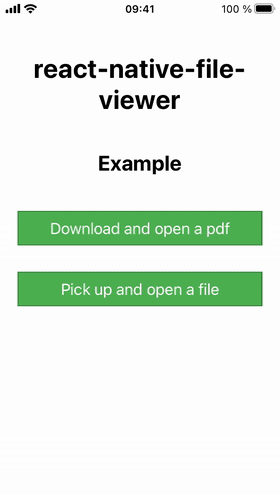Native file viewer for react-native. Preview any type of file supported by the mobile device.
iOS: it uses QuickLook Framework
Android: it uses ACTION_VIEW Intent to start the default app associated with the specified file.
Windows: Start the default app associated with the specified file.
$ npm install react-native-file-viewer --save
or
$ yarn add react-native-file-viewer
# RN >= 0.60
cd ios && pod install
# RN < 0.60
react-native link react-native-file-viewer
If your project is based on Expo, you need to eject your project by switching to the Bare workflow, in order to use this library.
Add the following to your Podfile:
pod 'RNFileViewer', :path => '../node_modules/react-native-file-viewer'
- In XCode, in the project navigator, right click
Libraries➜Add Files to [your project's name] - Go to
node_modules➜react-native-file-viewerand addRNFileViewer.xcodeproj - In XCode, in the project navigator, select your project. Add
libRNFileViewer.ato your project'sBuild Phases➜Link Binary With Libraries - Run your project (
Cmd+R)
- Open up
android/app/src/main/java/[...]/MainApplication.java
- Add
import com.vinzscam.reactnativefileviewer.RNFileViewerPackage;to the imports at the top of the file - Add
new RNFileViewerPackage()to the list returned by thegetPackages()method
-
Append the following lines to
android/settings.gradle:include ':react-native-file-viewer' project(':react-native-file-viewer').projectDir = new File(rootProject.projectDir, '../node_modules/react-native-file-viewer/android') -
Insert the following lines inside the dependencies block in
android/app/build.gradle:compile project(':react-native-file-viewer') -
Locate
react-native-file-viewerinsidenode_modulesfolder and copyandroid/src/main/res/xml/file_viewer_provider_paths.xmlto your projectres/xml/directory -
Add the following lines to
AndroidManifest.xmlbetween the main<application></application>tag:... <application> ... <provider android:name="com.vinzscam.reactnativefileviewer.FileProvider" android:authorities="${applicationId}.provider" android:exported="false" android:grantUriPermissions="true"> <meta-data android:name="android.support.FILE_PROVIDER_PATHS" android:resource="@xml/file_viewer_provider_paths" /> </provider> </application> ....
Follow the instructions in the 'Linking Libraries' documentation on the react-native-windows GitHub repo. For the first step of adding the project to the Visual Studio solution file, the path to the project should be ../node_modules/react-native-file-viewer/windows/RNFileViewer/RNFileViewer.csproj.
import FileViewer from 'react-native-file-viewer';
const path = // absolute-path-to-my-local-file.
FileViewer.open(path)
.then(() => {
// success
})
.catch(error => {
// error
});Pick up and open a local file #1 (using react-native-document-picker)
import FileViewer from "react-native-file-viewer";
import DocumentPicker from "react-native-document-picker";
try {
const res = await DocumentPicker.pick({
type: [DocumentPicker.types.allFiles],
});
await FileViewer.open(res.uri);
}
catch(e) {
// error
}Pick up and open a local file #2 (using react-native-image-crop-picker)
import FileViewer from "react-native-file-viewer";
import ImagePicker from "react-native-image-crop-picker";
ImagePicker.openPicker({})
.then(image => FileViewer.open(image.path))
.catch(error => {
// error
});Prompt the user to choose an app to open the file with (if there are multiple installed apps that support the mimetype)
import FileViewer from 'react-native-file-viewer';
const path = // absolute-path-to-my-local-file.
FileViewer.open(path, { showOpenWithDialog: true })
.then(() => {
// success
})
.catch(error => {
// error
});Since the library works only with absolute paths and Android assets folder doesn't have any absolute path, the file needs to be copied first. Use copyFileAssets of react-native-fs.
Example (using react-native-fs):
import FileViewer from 'react-native-file-viewer';
import RNFS from 'react-native-fs';
const file = 'file-to-open.doc'; // this is your file name
// feel free to change main path according to your requirements
const dest = `${RNFS.DocumentDirectoryPath}/${file}`;
RNFS.copyFileAssets(file, dest)
.then(() => FileViewer.open(dest))
.then(() => {
// success
})
.catch(error => {
/* */
});Download and open a file (using react-native-fs)
No function about file downloading has been implemented in this package. Use react-native-fs or any similar library for this purpose.
Example (using react-native-fs):
import RNFS from 'react-native-fs';
import FileViewer from 'react-native-file-viewer';
import { Platform } from 'react-native';
const url = 'https://github.com/vinzscam/react-native-file-viewer/raw/master/docs/react-native-file-viewer-certificate.pdf';
// Feel free to change main path according to your requirements.
// IMPORTANT: A file extension is always required on iOS.
// You might encounter issues if the file extension isn't included
// or if the extension doesn't match the mime type of the file.
const localFile = `${RNFS.DocumentDirectoryPath}/temporaryfile.pdf`;
const options = {
fromUrl: url,
toFile: localFile
};
RNFS.downloadFile(options).promise
.then(() => FileViewer.open(localFile))
.then(() => {
// success
})
.catch(error => {
// error
});| Parameter | Type | Description |
|---|---|---|
| filepath | string | The absolute path where the file is stored. The file needs to have a valid extension to be successfully detected. Use react-native-fs constants to determine the absolute path correctly. |
| options (optional) | Object | Some options to customize the behaviour. See below. |
| Parameter | Type | Description |
|---|---|---|
| displayName (optional) | string | Customize the QuickLook title (iOS only). |
| onDismiss (optional) | function | Callback invoked when the viewer is being dismissed (iOS and Android only). |
| showOpenWithDialog (optional) | boolean | If there is more than one app that can open the file, show an Open With dialogue box (Android only). |
| showAppsSuggestions (optional) | boolean | If there is not an installed app that can open the file, open the Play Store with suggested apps (Android only). |
The library supports Android X and React Native 0.60+.
If you're using React Native < 0.60, please append the following snippet to your android/app/build.gradle file:
preBuild.doFirst {
ant.replaceregexp(match:'androidx.core.content.', replace:'android.support.v4.content.', flags:'g', byline:true) {
fileset(dir: '../../node_modules/react-native-file-viewer/android/src/main/java/com/vinzscam/reactnativefileviewer', includes: '*.java')
}
}
If you prefer to not touch your gradle file, you can still use version 1.0.15 which is perfectly compatible.
